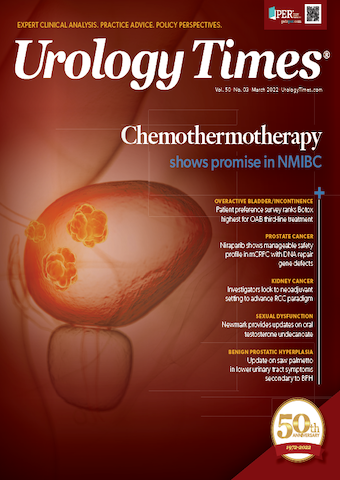Publication
Article
Urology Times Journal
PARP inhibitor niraparib shows promise in mCRPC with DNA repair gene defects
Author(s):
The PARP inhibitor niraparib demonstrated promising clinical activity in patients with metastatic castration-resistant prostate cancer (mCRPC) and DNA repair gene defects (DRDs), such as BRCA1/2 mutations, according to findings from the phase 2 GALAHAD trial published in The Lancet Oncology.1
At a median follow-up of 10 months, an objective response was reached by 34.2% of patients with a BRCA mutation and measurable disease. The median duration of response was 5.55 months.
“Niraparib is tolerable and shows antitumor activity in heavily pretreated patients with metastatic castration-resistant prostate cancer and DRDs, particularly in those with BRCA alterations,” the study authors wrote.
In the multicenter, open-label, single-arm GALAHAD trial, investigators evaluated the efficacy and safety of niraparib in the treatment of adult patients with mCRPC and DRDs who had received treatment with next-generation AR-targeting therapies and docetaxel.
To be eligible for enrollment, patients with mCRPC had to be biomarker positive for DRD and had progressed on ≥1 AR-targeted therapy and ≥1 taxane-based chemotherapy. No prior PARP inhibition or platinum-based chemotherapy was permitted, and patients could not have had a prior diagnosis of myelodysplastic syndromes or acute myeloid leukemia.
Niraparib was administered at 300 mg once daily until end of treatment and patients were followed up every 3 months until therapy was complete. The primary end point was ORR of soft tissue (visceral or nodal disease), as defined by RECIST1.1 criteria with no evidence of bone progression according to Prostate Cancer Working Group 3 criteria in those with biallelic BRCA mutations.
Overall, there were 289 patients enrolled in the trial betweenSept 28, 2016, and June 26, 2020. Of these patients, 63% (n = 182) had been treated with at least 3 systemic therapies for prostate cancer. The final efficacy analysis included 77% (n = 223) of the enrollment population. Of this group, there were 142 patients with BRCA1 or BRCA2 mutations and 81 patients who did not have BRCA mutations, but did harbor one of these other non-BRCA DRD alterations: ATM, BRIP1, CHEK2, FANCA, HDAC2, and PALB2. Further, among the 142 BRCA-positive patients, 76 had measurable disease. In the non-BRCA group, 47 of 81 patients had measurable disease.
Twenty-six (34.2%) of the 76 patients with a BRCA mutation and measurable disease had an objective response. There were 2 complete responses and 24 partial responses. Eight (31%) of the 26 responders remained in response at the time of the study data cutoff.
Among the 47 patients without BRCA mutations, the objective response rate was 10.6% (n = 5). All of the responses were partial responses.
All 289 patients were included in the safety analysis population. Treatment-emergent adverse events [TEAEs] across all grades that occurred most frequently were nausea (58%), anemia (54%), and vomiting (38%) The most common grade ≥3 TEAEs were anemia (33%), thrombocytopenia (16%), and neutropenia (10%). There were 2 deaths caused by AEs (urosepsis and sepsis) that were potentially related to niraparib treatment.
Based on earlier findings from the GALAHAD study, the FDA previously granted niraparib a Breakthrough Therapy Designation for the treatment of patients with BRCA1/2-mutant mCRPC who have previously received taxane-based chemotherapy and an androgen receptor inhibitor.
In the concluding remarks of their manuscript, the authors wrote, “These results suggest that niraparib has promising clinical activity with a manageable safety profile when administered as a monotherapy for treatment-refractory metastatic castration-resistant prostate cancer with BRCA alterations or select non-BRCA alterations. Such findings underscore the need for and importance of molecular testing to inform management along with continued research to establish treatment paradigms with appropriately targeted therapies for patients with prostate cancer.”
“Efforts to investigate and better understand predictive markers and signatures of both response and resistance to treatment with PARP inhibitors such as niraparib are needed to guide therapy selection and optimize treatment outcomes,” the authors added.
Reference
1. Smith MR, Scher HI, Sandhu S, et al. Niraparib in patients with metastatic castration-resistant prostate cancer and DNA repair gene defects (GALAHAD): a multicentre, open-label, phase 2 trial [published online ahead of print February 4, 2022]. Lancet Oncol. doi: 10.1016/S1470-2045(21)00757-9.

Newsletter
Stay current with the latest urology news and practice-changing insights — sign up now for the essential updates every urologist needs.






























